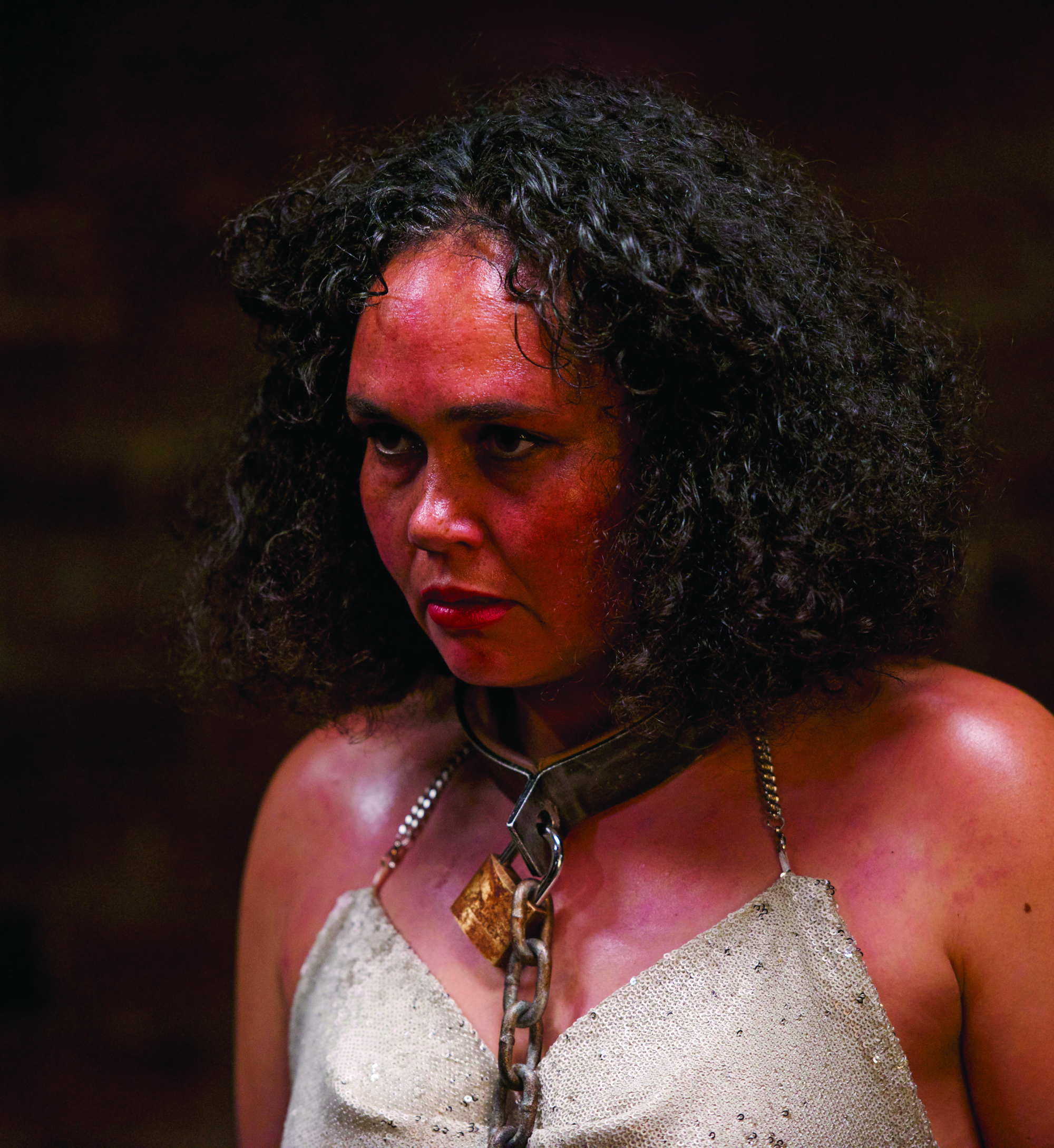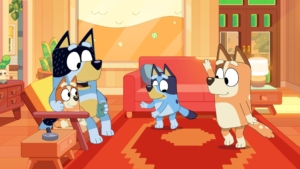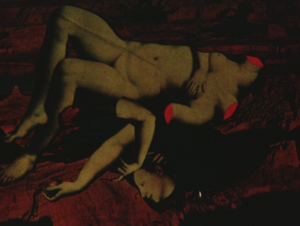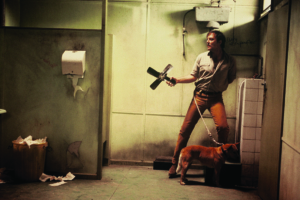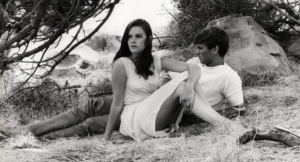Dark Place (2019)is an anthology work comprised of five short films that variously represent the horrors of the Australian settler-colonial mythscape. Premiering at the 2019 Sydney Film Festival, the shorts – all made by Indigenous filmmakers – explore themes such as enslavement, monstrosity, possession and torture, among others. Such ideas resonate with philosopher Achille Mbembe’s conception of ‘necropolitics’, which posits that ‘[t]o exercise sovereignty is to exercise control over mortality and to define life as the deployment and manifestation of power’.[1]Achille Mbembe, ‘Necropolitics’, trans. Libby Meintjes, Public Culture, vol. 15, no. 1, Winter 2003, p. 12. This refracted expression of Foucauldian ‘biopower’[2]For a primer on philosopher Michel Foucault’s notion of ‘biopower’, see Mark Kelly, ‘Biopower’, in ‘Michel Foucault: Political Thought’, Internet Encyclopedia of Philosophy, <https://www.iep.utm.edu/fouc-pol/#H7>, accessed 23 October 2019. underpins the ways in which particular bodies – here, those of Indigenous people – are precariously suspended between life and death.
As is typical of the horror genre, the Dark Place shorts attempt to evoke fears around haunted pasts, isolation, the unknown and the supernatural. Kodie Bedford’s ‘Scout’ is a female revenge film in which enslaved Indigenous women reclaim their lives. In Liam Phillips’ ‘Foe’, the spectre of grief reveals itself as an insomniac’s evil twin. An Indigenous single mum struggles against witchcraft in Rob Braslin’s suburban horror ‘Vale Light’. Vampires, possession and the Australian Gothic are convergent motifs in Perun Bonser’s ‘The Shore’, about a father and daughter isolated in the bush. And Bjorn Stewart’s ‘Killer Native’ is a historical-comedy zombie piece, staging first contact as a blood-spattered slapstick comedy. As these works evidence, the horrific reverberations of colonisation can give rise to cinematic complexity and a structuring logic, while simultaneously burdening Indigenous filmmakers with the arduous duty of ‘correcting’ (via depiction) this colonial history.
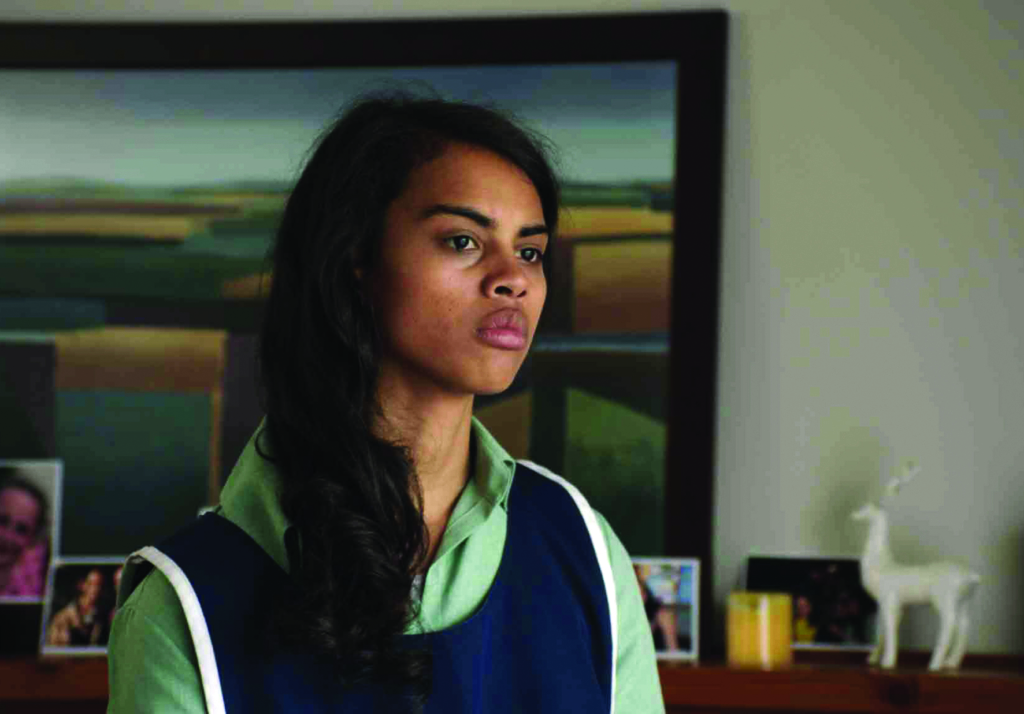
When representing Indigenous lives on screen, Indigenous filmmakers are caught between an acceptance of the prevailing colonial, epistemically violent narrative and an obligation to (re)produce Indigeneity through filmic ‘counter-narratives’ of resistance. Both approaches negate the specificity of Indigenous experience, however. While it is necessary to challenge popular colonial narratives, Maori-studies scholar Brendan Hokowhitu suggests that depicting the indigenous subject as a defiant decolonial voice risks marginalising
[s]ubjugated populations of Indigenous peoples, including the Indigenous underclass, Indigenous women, Indigenous LGBTQ, and generally those Indigenous peoples who feel excluded from the dominant forms of Indigenous ontologies that have been given the authority to represent ‘authentic’ indigeneity.[3]Brendan Hokowhitu, ‘Monster: Post-Indigenous Studies’, in Aileen Moreton-Robinson (ed.), Critical Indigenous Studies: Engagements in First World Locations, The University of Arizona Press, Tucson, 2016, p. 84.
When representing Indigenous lives on screen, Indigenous filmmakers are caught between an acceptance of the prevailing colonial, epistemically violent narrative and an obligation to (re)produce Indigeneity through filmic ‘counter-narratives’ of resistance.
Both ‘Killer Native’ and ‘Scout’, for example, embody the counter-narrative approach while accommodating a conception of Indigeneity shaped by the events and processes of colonisation. The latter film’s suffering, subjugated Indigenous characters, in particular, resist European influence through violent and self-gratifying acts of revenge, condemning the coloniser’s value system that has deemed Indigenous women’s bodies ‘valueless’ outside of sexual commodification. In turn, ‘Killer Native’ ironically locates ‘authentic’ Indigeneity in a ‘lost’ past, portraying a ‘bush blackfella’ character who survives the colonial encounter because he’s ‘in touch with nature’.
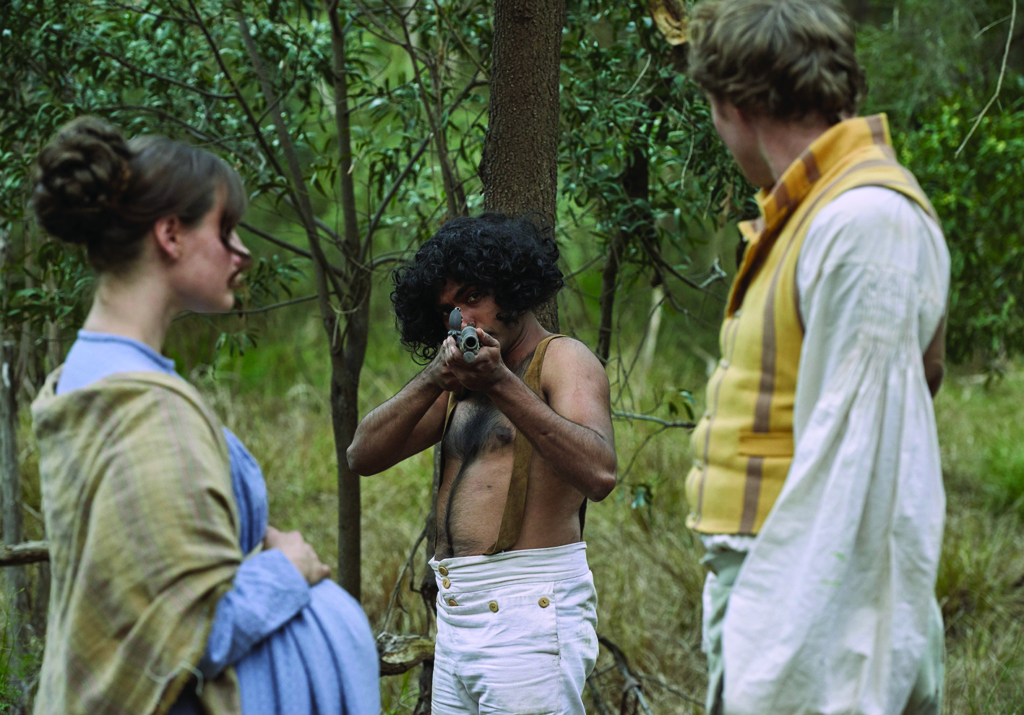
In their 2014 essay ‘The Burden of Historical Representation’, academics Jeremy Stoddard, Alan Marcus and David Hicks take the truism ‘history is written by the victors’ as a point of departure, contending that this ‘is as true for history films as it is for the historical record’.[4]Jeremy Stoddard, Alan Marcus & David Hicks, ‘The Burden of Historical Representation: The Case of/for Indigenous Film’, The History Teacher, vol. 48, no. 1, November 2014, p. 9. The authors then propose that corrective histories and counter-narratives from indigenous perspectives have political and pedagogical potential, thereby making a case for the importance of indigenous representation.[5]ibid., pp. 31–4. Yet this type of reactive approach often relies on what Hokowhitu describes as a ‘generalizable Indigenous ontology and taxonomy’. As ‘Killer Native’ and ‘Scout’ show, ‘Indigenous representation’ becomes coded in colonial grief and loss – a strategic essentialism that defines ‘true’ Indigenous culture as one existing only before the arrival of Europeans.[6]See Hokowhitu, op. cit., p. 85. Such filmic depictions’ over-reliance on reified ideas of Indigeneity risks them not being ‘counter-narrative’ at all; instead, they become supplementary narratives within the prevailing colonial record. Nevertheless, I maintain that the vectors of ‘historical record’ and filmic representations of history bleed into one another, discursively shaping popular understandings of the past today.
‘Scout’ reminds viewers of colonisation’s ongoing process of dehumanisation, showing how Indigenous women have been rendered – to appropriate critical theorist Judith Butler’s term – ‘ungrievable’.[7]Judith Butler, ‘Precariousness and Grievability – When Is Life Grievable?’, Verso blog, 16 November 2015, <https://www.versobooks.com/blogs/2339-judith-butler-precariousness-and-grievability-when-is-life-grievable>, accessed 22 October 2019. The titular protagonist (Katherine Beckett) is one of a group of Indigenous women held captive as sex slaves in a grotesque shipping container. The women are kept alive, but always in a state of injury, being subject to procedural physical abuse – recalling what Mbembe calls ‘death-in-life’.[8]Mbembe, op. cit., p. 21. The character Jodie (Shakira Clanton) articulates their state of entrapment in dialogue:
Cops have told everyone that we’ve gone walkabout. White girls go missing, it’s live TV, search parties and those white feminists that march in ya name. Black gins go missing … I didn’t need to be in here to know I’m nothing – we’re nothing!
Compounding the film’s depiction of the women’s stark reality is the gruesome mise en scène – dark lighting, dirty surfaces, tight spaces, scarce furnishings – punctured with scenes of viscerally affective body horror. In its entirety, ‘Scout’ is aesthetically dissonant: the naturalistic acting, choreography and dialogue are incongruous with the highly stylised sets and laboured themes. Yet each of these seemingly disparate elements contributes complexity to the female revenge narrative. Potent symbols like iron shackles connect the violent, gendered history of colonisation to contemporary ‘postcolonial’ society. When Scout realises that, to escape, she must annihilate the men who have tormented her, her brutal act of retribution offers not only a literal escape from her physical confines, but an ontological one as well, severing her connection to the master–slave relationship that has defined her being up until that decisive moment. The film ends with the women fleeing over the fence, departing the hermetic world of ‘Scout’.
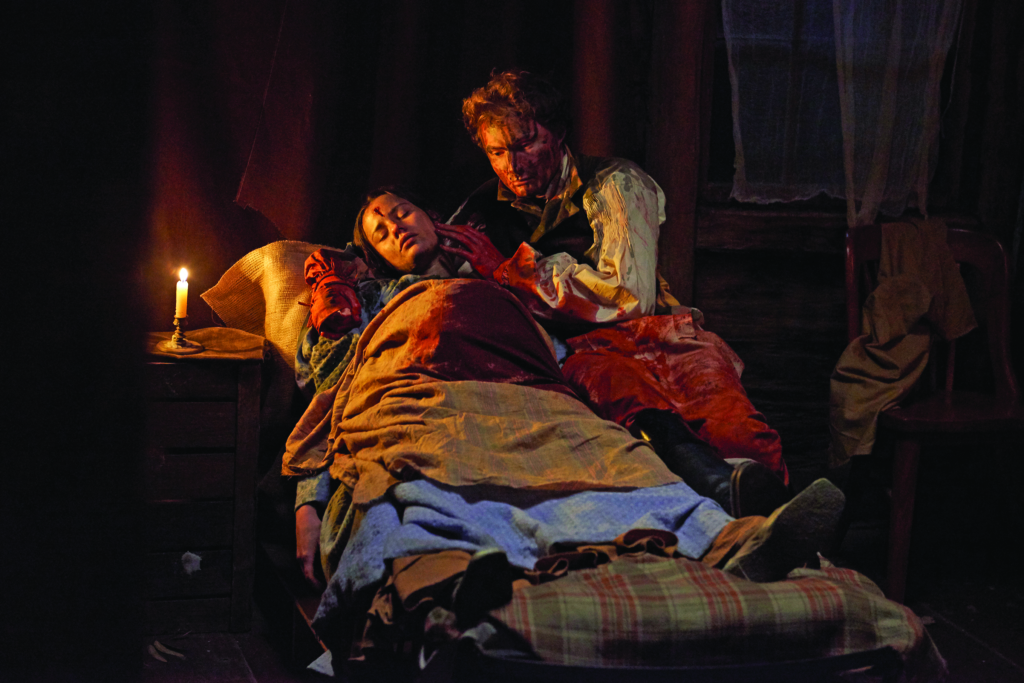
One way that history is commonly reconfigured to include Indigenous experiences and perspectives is by subverting the colonial archive. In ‘Killer Native’, the predominant settler–Indigenous encounter narrative is interrupted by being infused with raucous slapstick humour. At first, the plot is familiar – two colonisers, Thomas (Charlie Garber) and pregnant wife Sally (Lily Sullivan), arrive on Indigenous land, claim it as ‘my land’, confront an Indigenous man (Clarence Ryan), then name him ‘Billy Black’ – but this equation is complicated by the addition of a mutated ghoul (Natasha Wanganeen). Menaced by the monstrous character, Thomas accidentally shoots Sally, killing her. Meanwhile, Billy Black is infected by the ghoul, who turns out to be his wife.
‘Killer Native’ dramatises the fear of ‘going native’, a key theme in colonial and postcolonial Gothic texts, notably Joseph Conrad’s 1899 novella Heart of Darkness. In the book, the narrator, Marlow, journeys along the Congo River in search of the ivory trader Kurtz, who, overwhelmed by the local indigenous population, has gone mad. Exhibiting a similar tendency towards hyperbole, Stewart crafts an allegory that channels the colonisers’ nightmare of being ‘possessed’ by the monstrous forces of the ‘native’.
Allegory offers a conduit for making the ungrievable grievable through the representation of disregarded historical atrocities against Indigenous peoples. But, as a humanising project, it also poses the threat of universalising – and oversimplifying – representations of Indigenous experiences.
In Shocking Representation, film scholarAdam Lowenstein asks, ‘What does cinematic horror have to tell us about the horrors of history?’[9]Adam Lowenstein, Shocking Representation: Historical Trauma, National Cinema, and the Modern Horror Film, Columbia University Press, New York, 2005, p. 1. Analysing a grim graveyard scene from Bob Clark’s Dead of Night (1974) featuring a Vietnam vet and his mother, Lowenstein highlights the role of what he terms the ‘allegorical moment’: ‘The film’s horrific images, sounds, and narrative combine with visceral spectator affect (terror, disgust, sympathy, sadness) to embody issues that characterize the historical trauma of the Vietnam War (gender, nation, generation, memory […]).’[10]ibid., p. 2. In this light, what’s at issue for Indigenous filmmakers working in the horror genre isn’t merely representing historical trauma; for Lowenstein, this type of allegory is underpinned by an understanding of trauma as a phenomenon collectively comprehensible to the mainstream viewer. It is a conception that results from the loss of lives considered valuable, lives that are mourned, and not those lives that are considered ungrievable – the ‘Others’ and ‘enemies’ of the dominant social group.[11]Butler, op. cit. For Indigenous filmmakers, the allegorical moment is thus as much a risk as it is a device. Allegory offers a conduit for making the ungrievable grievable through the representation of disregarded historical atrocities against Indigenous peoples. But, as a humanising project, it also poses the threat of universalising – and oversimplifying – representations of Indigenous experiences.
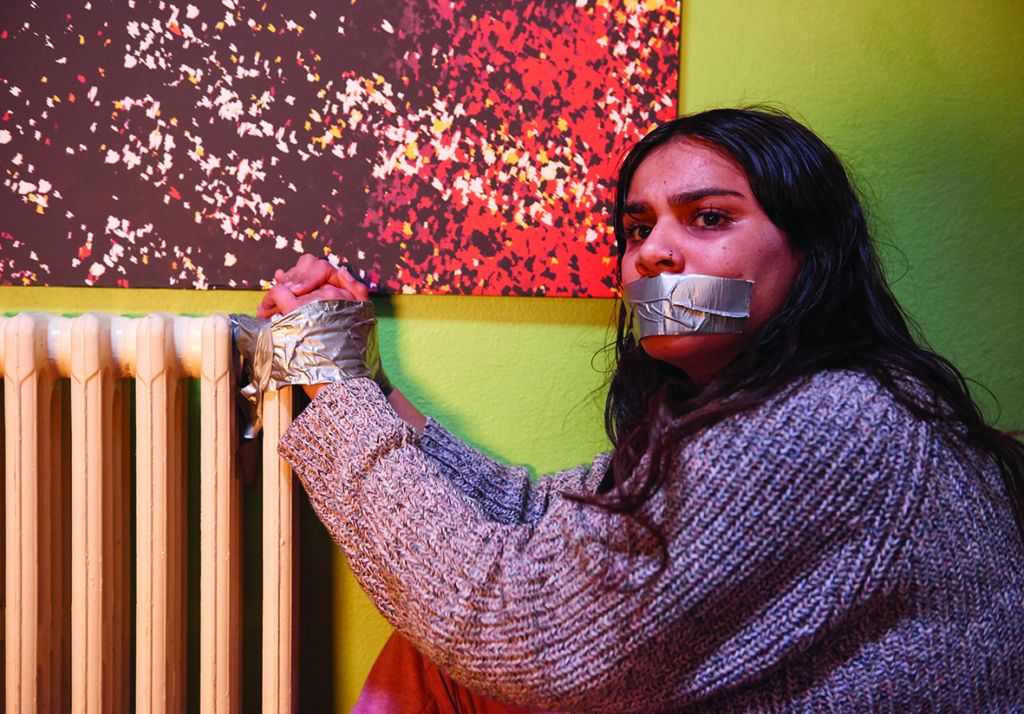
Another allegorical narrative can be found in ‘Foe’, which blurs the line between intergenerational trauma and a particularly bad case of insomnia caused by grief. Elena (Leonie Whyman) struggles to sleep – and, when she does, she sleepwalks. One morning, she finds a bloodied knife, leading her to suspect that she may have harmed someone during the previous night’s somnambulism. All of this may be happening because Elena has lost her mother. She studies photos of and eerie paintings by her deceased parent, which seem to want to speak to her; these scenes suggest that there is something deeper going on outside of the representational frame – something Elena doesn’t want to face. While trauma and repressed grief are common themes in works of horror, so is the confrontation with a shadowy, monstrous self that exposes ‘what lurks beneath’.[12]In Jordan Peele’s recent horror film Us (2019), for example, subterranean doppelgangers emerge to terrorise their counterparts above ground, who are unaware of the mirrored, rudimentary world beneath their happy, terrestrial middle-class society. Eventually, Elena is captured and left to burn in her own home by a spectral figure of herself – her malicious double.
Like Elena in ‘Foe’, the protagonists of ‘The Shore’ must face a part of themselves that they have repressed. A Gothic tale set in the bush by a river, it creates tension visually, using studied black-and-white shots and oblique lighting to produce unnerving shadows and an atmosphere of murky stillness. The short quietly follows Barry (Bernard Curry) and his daughter, Selena (Luka May Glynn-Cole); it is initially suggested that the pair are under attack by a bloodsucking creature, with Barry dying in the opening scene from a neck wound resembling a vampire’s bite. Later, Selena ventures into the river, where she encounters and assaults her own mother (Bee Cruse) – who may have been responsible for Barry’s death. Selena then tears open her mother’s neck in true vampire style, unable to suppress her innate thirst for blood.
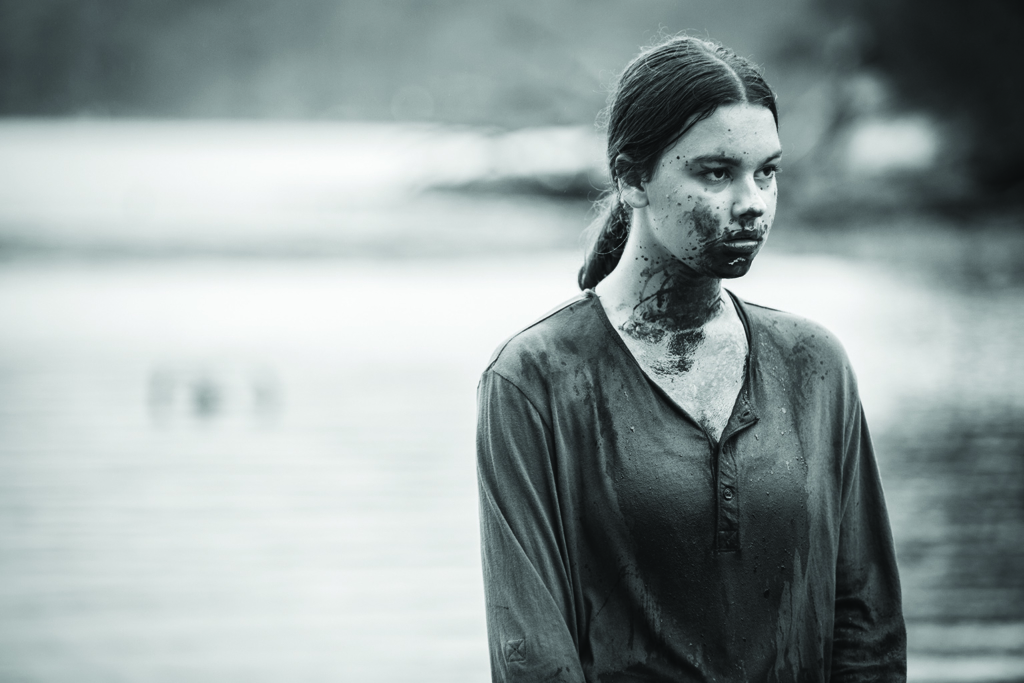
‘To speak of history’s horrors, or historical trauma,’ suggests Lowenstein, ‘is to recognize events as wounds […] in the fabric of culture and history that bleed through conventional confines of time and space.’[13]Lowenstein, op. cit., p. 1. Trauma distorts reality; an event stays with an affected individual or a group, dramatically shaping their experience long after it has occurred. Yet, as ‘Vale Light’ captures, settler-colonialism is not simply an event, but an ongoing project of Indigenous erasure – a wound wherein the dagger remains in place, preventing healing. Braslin’s short explores the precariousness of life for Indigenous peoples. Shae (Tasia Zalar), an Indigenous single mum, and her daughter, Isabelle (Jolie Everett), are homeless, with no choice but to sleep in their car; the vehicle is packed with their belongings, reminding viewers of the insecurity of their living situation. Seemingly, their fortune improves when they find shelter in a suburban house, but their new home comes with an unsettling neighbour: Diane (Sara Pensalfini), a villainous Caucasian witch.
Diane appears to be ageing at an accelerated rate, has a penchant for collecting Orientalist objects and is suspiciously interested in Isabelle. After the witch captures her and uses mind control on her mother, Isabelle finds the strength to tap into her own supernatural abilities. She then overpowers Diane, finally granting her and her mother a semblance of normalcy. In this way, the arc of ‘Vale Light’ dramatises the ongoing threat of displacement: homeless and without support, Shae and Isabelle grapple with a life exposed to the necropolitics of colonialism. The witch next door is a reminder of the constant threats that mark their lives, even in supposed safety. As Butler has asserted of such circumstances:
To say that a life is injurable […] or that it can be lost, destroyed, or systematically neglected to the point of death, is to underscore not only the finitude of a life […] but also its precariousness.[14]Butler, op. cit.

The dynamics between the two Indigenous women and the ageing white woman in ‘Vale Light’ also bring to mind Tracey Moffatt’s masterful Night Cries: A Rural Tragedy (1990). Richly layered and self-reflexive, the film tells the story of an Aboriginal woman who is caring for her dying white adoptive mother in a surreal, isolated rural Australian setting. ‘Vale Light’ lacks the formal innovation and conceptual potency of Night Cries, but, like Moffatt’s film, it addresses issues relating to race and assimilation as they impact on maternal power. For Moffatt’s protagonist, agency is seized back through expressions of thinly veiled hostility. For Shae and Isabelle, the door to a newfound solitude opens when Isabelle reproduces the white woman’s villainous witchcraft to take back power.
In Heart of Darkness, ‘The horror! The horror!’ is the cry Kurtz utters in the Congo as his final judgement on his life – and on imperialism itself. Marlow, who has witnessed Kurtz’s descent into madness, realises that such a statement cannot be relayed upon his return to Europe, so he replaces it with a civil lie, so as to maintain ‘normalcy’. The colonial horror that Kurtz has witnessed is unrepresentable; in much the same way, the potency of Dark Place lies not in the films that comprise it – in their ability to evoke nightmarish fears that correspond with the expectations of the horror genre or represent the horrors of colonialism – but in what lies beyond the stories they tell. Returning to ‘Scout’, the true power is found after the revenge, after Scout has jumped the fence.
Endnotes
| 1 | Achille Mbembe, ‘Necropolitics’, trans. Libby Meintjes, Public Culture, vol. 15, no. 1, Winter 2003, p. 12. |
|---|---|
| 2 | For a primer on philosopher Michel Foucault’s notion of ‘biopower’, see Mark Kelly, ‘Biopower’, in ‘Michel Foucault: Political Thought’, Internet Encyclopedia of Philosophy, <https://www.iep.utm.edu/fouc-pol/#H7>, accessed 23 October 2019. |
| 3 | Brendan Hokowhitu, ‘Monster: Post-Indigenous Studies’, in Aileen Moreton-Robinson (ed.), Critical Indigenous Studies: Engagements in First World Locations, The University of Arizona Press, Tucson, 2016, p. 84. |
| 4 | Jeremy Stoddard, Alan Marcus & David Hicks, ‘The Burden of Historical Representation: The Case of/for Indigenous Film’, The History Teacher, vol. 48, no. 1, November 2014, p. 9. |
| 5 | ibid., pp. 31–4. |
| 6 | See Hokowhitu, op. cit., p. 85. |
| 7 | Judith Butler, ‘Precariousness and Grievability – When Is Life Grievable?’, Verso blog, 16 November 2015, <https://www.versobooks.com/blogs/2339-judith-butler-precariousness-and-grievability-when-is-life-grievable>, accessed 22 October 2019. |
| 8 | Mbembe, op. cit., p. 21. |
| 9 | Adam Lowenstein, Shocking Representation: Historical Trauma, National Cinema, and the Modern Horror Film, Columbia University Press, New York, 2005, p. 1. |
| 10 | ibid., p. 2. |
| 11 | Butler, op. cit. |
| 12 | In Jordan Peele’s recent horror film Us (2019), for example, subterranean doppelgangers emerge to terrorise their counterparts above ground, who are unaware of the mirrored, rudimentary world beneath their happy, terrestrial middle-class society. |
| 13 | Lowenstein, op. cit., p. 1. |
| 14 | Butler, op. cit. |
